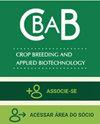Classifying coefficients of genetic variation and heritability for Eucalyptus spp.
IF 1.1
4区 农林科学
Q2 Agricultural and Biological Sciences
引用次数: 3
Abstract
: The objective of this study was to establish classification ranges for genetic and additive genetic coefficients of variation, as well as for broad and narrow sense heritability, as a function of growth and wood quality traits for Eucalyptus spp. We conducted statistical analyses to determine differences in this classification the types of coefficients used. The selected studies that met the inclusion criteria, 58 presented genetic variation coefficients (448 data points) and 53 presented heritability coefficients (423 data points). To descriptive statistics and the Shapiro-Wilk test, we confirmed that it was necessary to separate coefficients and traits into groups. Inconsistencies for growth traits were observed, confirming the influence of experimental error, indirect estimation methods, and environmental effects on coefficient estimates. We recommend the use of the classification tables included in this literature review to interpret results in studies so as to standardize the classification of coefficients of genetic variation and heritability.桉树属遗传变异和遗传力分类系数。
摘要:本研究的目的是建立桉树遗传变异系数和加性遗传变异系数的分类范围,以及广义遗传力和狭义遗传力与生长性状和木材品质性状的关系,并通过统计分析确定该分类中使用系数类型的差异。入选的符合纳入标准的研究中,遗传变异系数58项(448个数据点),遗传力系数53项(423个数据点)。通过描述性统计和夏皮罗-威尔克检验,我们证实了将系数和性状分开分组的必要性。观察到生长性状的不一致性,证实了实验误差、间接估计方法和环境效应对系数估计的影响。我们建议使用本文献综述中的分类表来解释研究结果,以规范遗传变异系数和遗传力系数的分类。
本文章由计算机程序翻译,如有差异,请以英文原文为准。
求助全文
约1分钟内获得全文
求助全文
来源期刊
CiteScore
2.40
自引率
13.30%
发文量
25
审稿时长
6-12 weeks
期刊介绍:
The CBAB – CROP BREEDING AND APPLIED BIOTECHNOLOGY (ISSN 1984-7033) – is the official quarterly journal of the Brazilian Society of Plant Breeding, abbreviated CROP BREED APPL BIOTECHNOL.
It publishes original scientific articles, which contribute to the scientific and technological development of plant breeding and agriculture. Articles should be to do with basic and applied research on improvement of perennial and annual plants, within the fields of genetics, conservation of germplasm, biotechnology, genomics, cytogenetics, experimental statistics, seeds, food quality, biotic and abiotic stress, and correlated areas. The article must be unpublished. Simultaneous submitting to another periodical is ruled out. Authors are held solely responsible for the opinions and ideas expressed, which do not necessarily reflect the view of the Editorial board. However, the Editorial board reserves the right to suggest or ask for any modifications required. The journal adopts the Ithenticate software for identification of plagiarism. Complete or partial reproduction of articles is permitted, provided the source is cited. All content of the journal, except where identified, is licensed under a Creative Commons attribution-type BY. All articles are published free of charge. This is an open access journal.

 求助内容:
求助内容: 应助结果提醒方式:
应助结果提醒方式:


